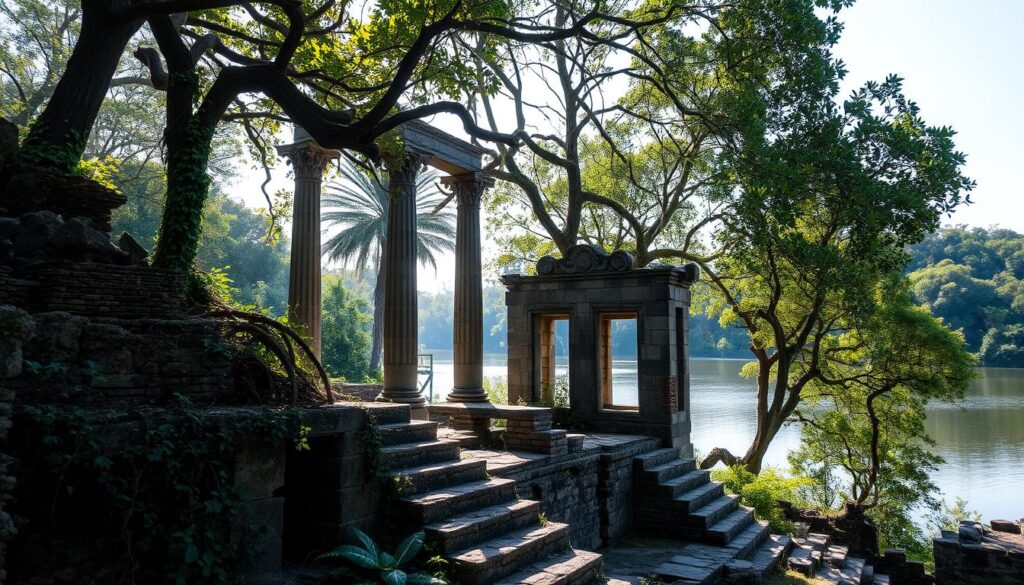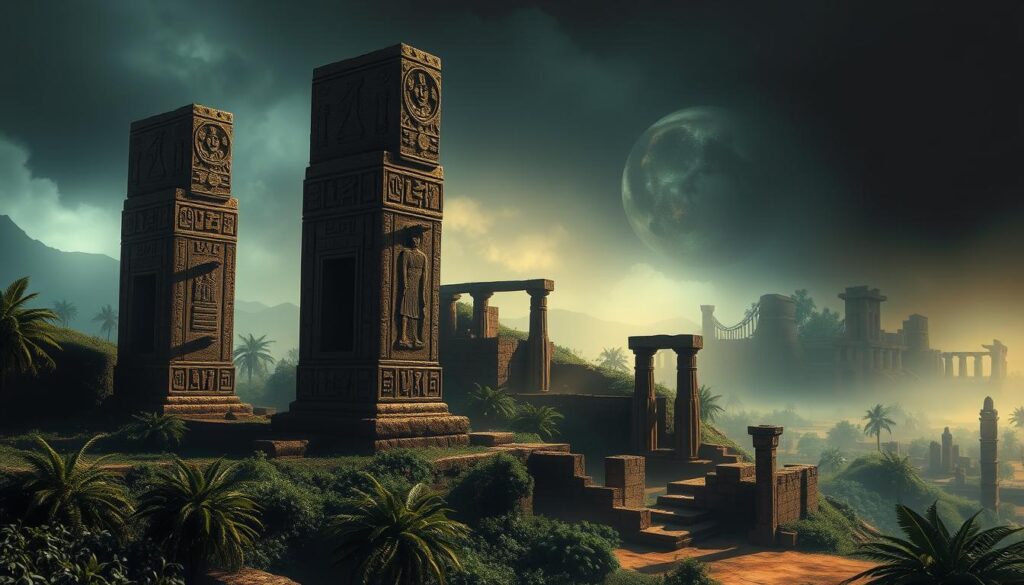History is full of secrets about societies that vanished without warning. Lost ancient civilizations have left us with clues that puzzle us. These clues challenge our views on human history.

The Maya of Central America and the Easter Island people are fascinating. But the Indus Valley Civilization is especially intriguing. It thrived from 3300–1300 BCE and had advanced cities, writing, and trade networks across Asia.
What could have led to the disappearance of such a civilization? Was it climate change, natural disasters, invasion, or something else? The answers are hidden in artifacts, structures, and symbols waiting to be uncovered.
Key Takeaways
- Lost ancient civilizations challenge our understanding of historical timelines
- The Indus Valley Civilization represents one of history’s most puzzling disappearances
- Archaeological evidence shows these societies were often highly advanced
- Multiple theories exist to explain these mysterious vanishings
- Modern technology is revealing new clues about ancient society collapses
- Climate factors may have played a significant role in these disappearances
- Cultural lessons from vanished civilizations remain relevant today
The Enigma of Lost Civilizations Throughout History
Many societies have come and gone, leaving behind only pieces of their lives. These lost civilizations puzzle experts who try to figure out why they vanished. From Mesopotamia’s cities to South America’s stone structures, their remains show us their creativity and mysterious ends.
The mystery of these historical mysteries lies in the unknown. The silence of old cities and forgotten languages raise questions science can’t solve. Why did the Nabta Playa astronomers disappear in Egypt? What happened to Göbekli Tepe’s creators?
Every find about these ancient vanished societies brings more questions. They built advanced irrigation, calendars, and buildings that today’s tech can’t match. Their achievements and disappearance make a puzzle that keeps archaeologists searching.
Famous Disappeared Cultures from Around the World
Examining the Civilization That Vanished Without a Trace
In the jungles of Central America, a sophisticated society vanished almost overnight. They left behind clues but took their secrets with them. Their story is one of the most intriguing in archaeology.
Archaeological Evidence of Their Existence
Stone foundations and ceremonial centers show they once existed. Since 2015, excavations have found homes covering over 50 square miles. This suggests a population of at least 100,000 people.
Recent finds include pottery with unique patterns and stone tools of advanced craftsmanship. These discoveries are unlike anything else in the region.
Cultural Achievements and Technological Advancements
This lost society made impressive achievements. They built irrigation systems to farm in areas thought unsuitable. Their buildings were aligned with the sun and stars, showing deep astronomical knowledge.
They also had a complex writing system. Scholars are still trying to understand it. Their script had pictographic elements.
The Sudden and Unexplained End
Their civilization collapsed around 850 CE. Buildings were left unfinished, and food was still cooking. This was unlike other ancient sites, which were abandoned gradually.
No signs of war, disease, or natural disasters were found. People left behind their belongings, suggesting they planned to return but never did. This mystery continues to intrigue researchers.
Historical Context: The World During Their Time
To understand this lost society, we must look at its role in ancient history. While our mystery civilization thrived, other civilizations around the world were also growing. They were each building their own unique cultures.
At this key time in history, many societies grew a lot. Trade networks spread far, linking distant groups. These networks brought goods, ideas, technologies, and cultural practices together.
The climate of that era was also important. Archaeology shows that many societies faced similar environmental challenges. These challenges led to changes in how they lived.
| Region | Contemporary Civilizations | Notable Developments |
|---|---|---|
| Mediterranean | Early Minoan culture | Maritime trade expansion |
| Mesopotamia | Akkadian Empire | Complex irrigation systems |
| East Asia | Xia Dynasty | Bronze metallurgy advances |
| Indus Valley | Harappan Culture | Urban planning innovations |
War, competition for resources, and alliances between groups shaped their world. Despite old transportation, societies knew about each other. This shows our mystery culture likely faced challenges like others did.
Clues Left Behind: Artifacts and Structures
The lost civilization left behind tangible clues. These clues give us a glimpse into their final days and why they vanished.
Significant Archaeological Discoveries
Recent digs have uncovered ancient artifacts that change how we see their tech. Clay tablets in ceremonial rooms show advanced astronomy. Burial sites with bodies in circles hint at rituals before a crisis.
Abandoned settlements reveal a sudden stop in life. Cooking pots still have food, tools are scattered, and valuable items are left behind.
Deciphering Ancient Texts and Symbols
Wall writings and tablets hold cryptic messages. Researchers are trying to understand them. Symbols of celestial events become more common, possibly warning of disasters.
The final written records speak of “darkness coming from the sky” and “the earth trembling beneath our feet” – phrases that might describe natural disasters rather than mythological events.
What Material Evidence Tells Us About Their Fate
The mysterious structures from their final days show quick construction. They have defensive features not seen before. Soil samples show ash from big fires, and historical evidence of crop failure is found in abandoned storage.
These clues suggest a mix of environmental disaster and conflict. Yet, no mass graves found, which makes violence alone unlikely as the cause.
Scientific Methods Used to Investigate the Disappearance
The search for our lost civilization has entered a new phase with advanced science. Today, researchers use advanced archaeological techniques that were once unimaginable. These methods allow us to uncover history with great detail.
Modern Archaeological Techniques
Archaeologists now have tools far beyond shovels and brushes. Lidar mapping uses laser pulses from planes to find hidden structures. Ground-penetrating radar lets scientists see what’s buried without touching it.
These tools have uncovered large settlement patterns that were missed before. Chemical analysis of pottery has shown trade networks were wider than thought. Dating techniques now pinpoint events with great accuracy, creating detailed timelines.
DNA and Genetic Tracing
Ancient DNA analysis has changed how we understand past populations. DNA from skeletal remains gives direct insights into the people. Scientists have found DNA in teeth and bone fragments, linking this culture to others.
Genetic markers suggest population movements that match the mysterious abandonment of sites. These markers are found in communities far away, dated just after the disappearance. This suggests migration rather than extinction.
Climate Data and Environmental Analysis
Paleoclimate research provides key environmental context for the civilization’s collapse. Ice cores from glaciers record yearly climate data. Tree ring studies show drought patterns that match settlement abandonment.
Lake sediment cores reveal changes in landscapes. This data shows a 30-year period of severe climate instability around the time of the civilization’s disappearance. The evidence suggests a society facing ecological pressure it couldn’t adapt to.
Popular Theories Behind the Mysterious Vanishing
Studying ancient civilizations is like trying to solve a big puzzle. There’s no one answer. Many theories exist, from scientific to speculative. Each one gives us a different view of what might have happened to this lost society.

One leading theory is environmental collapse. It’s thought that long droughts might have ruined their crops. This could have forced them to leave their homes. Climate data from ice cores and lake sediments backs this up, showing big changes in the weather during their last days.
Natural disasters are another theory. The area had earthquakes that could have damaged important buildings. Volcanic eruptions might have also hurt their crops by blocking sunlight with ash.
- Disease epidemics spreading through dense population centers
- External invasion disrupting societal structures
- Internal conflict leading to governance breakdown
- Resource depletion forcing migration to new territories
Some researchers think the society might have chosen to spread out. They might have joined other cultures instead of disappearing. Another idea is that trade network failures could have cut them off, making it hard to survive.
The real story might be a mix of all these factors. New ways to study ancient sites are helping us find clues. These discoveries both support and question the old theories, keeping the mystery alive.
Comparing Similar Historical Disappearances
Studying vanished civilizations gives us deep insights into human history. Looking at cultures that vanished quickly, we find common themes. These help us understand our focus civilization better.
Patterns Among Vanished Societies
Many cultures vanished due to environmental stress, resource depletion, and social conflict. The Anasazi in North America left their cliff dwellings during a long drought. Easter Island’s people collapsed after cutting down all their trees and using up resources.
The Khmer Empire at Angkor faced big climate challenges that made their water systems fail. These examples show how environmental and social issues can lead to collapse.
Lessons from Other Archaeological Mysteries
Many ancient mysteries have been solved with new research tools. The Maya’s decline was once thought to be one event, but now we see it was a mix of drought, war, and political troubles. The Norse in Greenland didn’t disappear suddenly but couldn’t adapt to changing conditions.
These solved mysteries teach us to look for complex reasons, not just one cause. They show that many factors can lead to a civilization’s downfall.
What Makes This Civilization’s Case Unique
Our focus civilization is special because it vanished completely, despite being advanced. Unlike the Maya or Angkor, there are no clear survivors or reasons for their disappearance. The lack of signs of violence, disease, or mass migration makes it even more mysterious.
| Vanished Civilization | Time Period | Primary Disappearance Factors |
|---|---|---|
| Maya (Classic) | 800-950 CE | Drought, warfare, political collapse |
| Easter Island | 1600-1700 CE | Resource depletion, ecological disaster |
| Angkor Civilization | 1300-1400 CE | Climate change, water management failure |
| Our Focus Civilization | [Time Period] | Unknown – absence of typical collapse markers |
Current Research and Recent Discoveries
Teams worldwide are still searching for answers about this lost civilization. They use new methods to study old questions. Recent finds have shown that this civilization was bigger than we thought.
Ongoing Archaeological Expeditions
In 2023, five big excavation sites started. They found amazing artifacts that change what we know. The University of Chicago found ritual objects from a time we thought was forgotten.
These digs now happen all year, not just in seasons. This means teams work together across many fields.

Technology Revealing New Insights
New tech has changed how we look at old ruins. Ground-penetrating radar found hidden underground chambers. DNA tests on pottery show links to distant populations, showing wide trade networks.
Academic Debates About Their Fate
The mystery is still unsolved, and debates are growing. Scientists can’t agree on what happened. Some think it was environmental disaster, others war, and a few suggest they might have moved on purpose.
| Theory | Key Evidence | Leading Proponents |
|---|---|---|
| Climate Change | Pollen samples showing drought | Cambridge Research Group |
| External Invasion | Weaponry and skeletal trauma | University of Texas Team |
| Epidemic Disease | Mass burial sites with no trauma | Montreal Institute |
Conclusion: The Enduring Mystery and What It Teaches Us
The mystery of this ancient civilization’s disappearance is still a big question. Archaeologists and scientists have found clues, but many questions remain. Lessons from vanished civilizations show us how fragile our societies are, even when they seem strong.
Looking at ancient collapses teaches us a lot. It shows how environmental, social, and technological issues can harm even the strongest cultures. Preserving historical knowledge about these lost worlds is key. It helps us understand our past and learn from today’s challenges like climate change and resource depletion.
The significance of historical mysteries is in connecting us to our shared humanity. Our fascination with lost civilizations shows our curiosity about human life, our strength, and our weakness over time. As we learn more about the past, we appreciate the fragility and strength of human life more.
FAQ
What is the purpose of studying disappeared civilizations?
Studying disappeared civilizations is fascinating. It challenges our view of history. These ancient mysteries spark our imagination and teach us about human societies’ strengths and weaknesses.
Looking into why they vanished can teach us lessons for today’s world. We face many global challenges, and learning from the past is crucial.
What are some of the most famous examples of disappeared civilizations?
Well-known examples include the Maya, Anasazi, Indus Valley civilization, and Easter Island’s inhabitants. These societies achieved great things but vanished, leaving us with many questions.
How do archaeologists investigate the disappearance of ancient civilizations?
Archaeologists use modern science to study ancient civilizations. They use advanced mapping, dating, genetic analysis, and environmental studies. By studying artifacts, structures, and records, they try to understand what led to their decline.
What are some of the leading theories proposed to explain the disappearance of our mystery civilization?
Many theories explain the disappearance of our mystery civilization. These include environmental changes, warfare, disease, and societal collapse. Experts debate these theories, trying to find the right mix of factors.
How do the lessons from other disappeared civilizations inform our understanding of this mystery?
Comparing our mystery civilization to others can show patterns and differences. Looking at environmental stress, resource depletion, and societal complexity can teach us about human vulnerabilities. Studying how other mysteries were solved can also guide our approach.
What recent discoveries and technological advancements are shedding new light on this ancient civilization?
New discoveries and technologies are changing our view of this civilization. Archaeological expeditions, satellite imagery, and artificial intelligence are uncovering new insights. These advancements keep the mystery alive in archaeological research.
